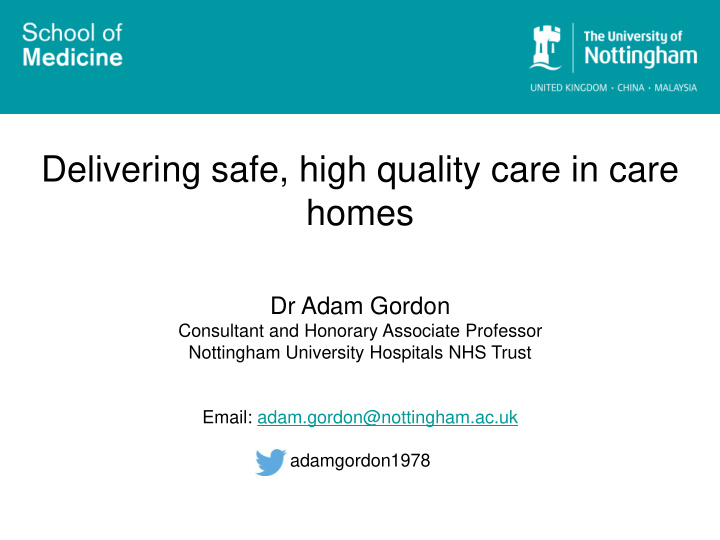



Delivering safe, high quality care in care homes Dr Adam Gordon Consultant and Honorary Associate Professor Nottingham University Hospitals NHS Trust Email: adam.gordon@nottingham.ac.uk adamgordon1978
Care Homes • Who lives in them? • What do they need? • How is care currently provided and does it meet their needs? • Challenges unique to the care home setting. • Some ways forward.
In the Care Home Outcome study…. The proportion of care home residents with cognitive impairment was: • 0-25% • 26-50% • 51-75% • 76-100%
In the Care Home Outcome study…. The proportion of care home residents with urinary incontinence was: • 0-25% • 26-50% • 51-75% • 76-100%
In the Care Home Outcome study…. The proportion of care home residents who were bed- or chair-bound was: • 0-25% • 26-50% • 51-75% • 76-100%
Some other headline figures…. • Average number of diagnoses – 6.2 • Median number of medications – 8 • 2/3 had some form of behavioural symptom • 30% malnourished • 56% at risk of malnutrition • Average life expectancy – 1 year for nursing homes – 2 years for residential homes
Effective healthcare responses will…. • Have expertise in management of: – Multiple diagnoses – Immobility – Incontinence – Challenging behaviour – Polypharmacy – Malnutrition – End-of-life care
Physical Mental/Psycholo gical CGA Functional Social Environmental
Assessment Stratified Goals problem list Bespoke Management Plan
What currently happens GP’s deliver care as part of GMS….although sometimes they don’t(!) GP:care home ratios vary 1:1-1:50 Reactive care models predominate Multidisciplinary team access is limited Roles and responsibilities aren’t clearly specified
Common problems Older people are very complicated. Trajectories are difficult to predict. Don’t have the training. Resources are tight. Regulation is always present. Roles and responsibilities aren’t clear. Communication is a problem.
Solutions have focused around… Remuneration – carrot. Regulation – stick. Parachuting in troops. Generating social movements.
Be careful what you wish for…. 1:1 relationship “I wouldn’t wish Trusting our GP/care relationship with home on my mutual respect worst enemy”
Challenges to QI in care homes Mixed economies of providers. Health vs Social Care. Unclear roles and responsibilities. Dependency on enthusiasts, with implications for sustainability.
Areas of Concern Falls Pressure ulcers Delirium Sepsis Malnutrition Dehydration Social isolation
Landielijke Pravelentiemeting Zorgproblemen (LPZ) Falls Pressure Ulcers Incontinence Malnutrition Intertrigo Physical restraints
Landielijke Pravelentiemeting Zorgproblemen (LPZ) Twice yearly measurement Single snap-shot Netherlands, Germany, Austria, Switzerland, New Zealand, Indonesia Benchmark against Historical Data Other Homes Other Countries
Trying out the LPZ in the East Midlands 30 homes across Nottinghamshire Mixture of nursing, residential, dementia registered and non-dementia registered Single snap-shot audit Pressure ulcers and malnutrition Concurrent process analysis Models of collaboration Barriers and facilitators to implementation. Data returned to East Mids for further analysis
Delivering safe, high quality care in care homes… Requires an understanding of who lives there. And who works there. And how to work with them. Roles, responsibilities and models of partnership central. Nobody quite knows how to do this yet. Some possible steps forward as part of PSC The PEACH study Trialling the LPZ.
Recommend
More recommend